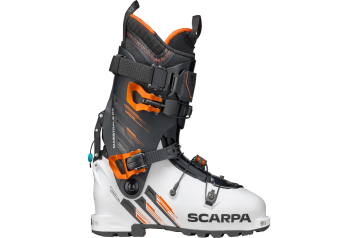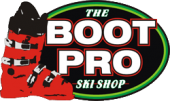Testers were a little bittersweet about the new Scarpa Maestrale RS because, well, they really liked the old Maestrale RS. But, as with most change, there were good things to look forward to as well in this same-name but very different Maestrale RS--particularly how well it skis! Testers gave the new Maestrale RS a perfect 5.00 in Edge Power, the highest score in that metric across the board in the Backcountry category. As expected the Maestrale RS didn't lose a step in its uphill game, with testers loving its stride length, smooth quality and light weight upon the foot--as usual.
This is a power-packed minimalist uphill-downhill machine, testers said, pointing to the carbon core inserts in the lower shell and cuff as the light and rigid foundation that bolstered the Grilamid Bio and Pebax R-New plastics' transmissive qualities. This boot delivered real alpine-level power to the edge, testers said, and while they said it was energetic and springy feeling, it wasn't fidgety and remained damp-enough when controlling big skis at speed over variable snow surfaces. More than one tester commented on its on-area descent capabilities and its confidence-inspiring reliability in demanding terrain.
For the right feet and leg shapes the Maestrale's downhill game sealed the deal for testers as their new favorite BC boot. For testers whose feet and legs fell outside (i.e. wider or higher volume) the Maestrale RS's fit map, well, they were less enthused. The new Maestrale RS fit is not as universally mediumish or forgiving (read, well-padded) as its predecessor. Testers described something of a platypus bill as the foot shape required for the new Maestrale RS--wide at the toes and forefoot and low, vertically, through the instep and midfoot. While the 102mm descriptor might indicate a wide fit, testers said that only related to the width at the forefoot, as the three-dimensional space was more snug-medium in fit character. Testers mentioned that the heel pocket and calf were particularly snug, which suited some of our testers perfectly.
The boot feels close to the snow, with very little bulk separating foot movements from ground feel, and testers liked this performance trait for quick and sensitive steering and edging movements. But the shell also feels quite close to the foot and the liner is spartan in its cushioning, so testers with wider or bonier feet found some hot spots to whine about.
Testers liked the updated features here, like a revised walk mode switch that they found easy and solid, and they liked the forward lean adjustment that offered a two-degrees more upright or more forward cuff position if needed. The variety of buckle and strap styles provided for some initial fiddling about, as cabrio BC boots will, but testers liked the closure system once they worked out the bugs.














Kudos
Caveats